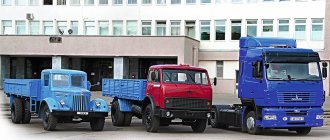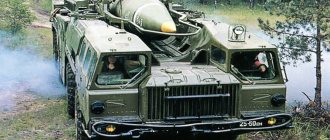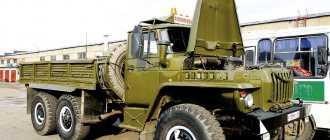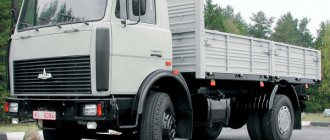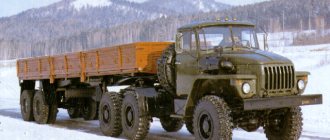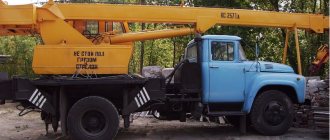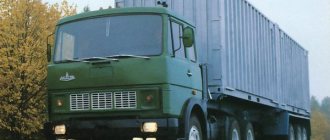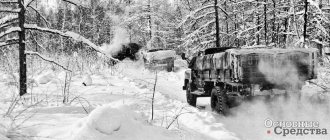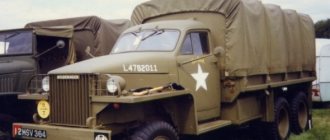Cabins "Ural-4320"
The Ural-4320 trucks were equipped with a metal two-door cabin designed for a driver and two passengers. The classic, traditional Uralov cabin has been produced for fifty years now, and, of course, the comfort indicators in it are infinitely far from modern ones. Although: the driver's seat is adjustable, there are ventilation and heating systems, there is power steering, and it is possible to equip the cabin with a sleeping place. If desired, the Ural-4320 can be equipped with an air conditioner, an independent heater and a Webasto pre-heater.
To create more comfortable travel conditions and better safety, since the spring of 2009, successful experiments have been undertaken to equip the newly developed Urals with new-style cabins. This is a license-manufactured cab without a hood with a fiberglass tail. It has three separate anatomical chairs with headrests, armrests, and seat belts.
In the interior decoration and cladding there are modern materials that provide good noise and heat insulation, a steering wheel with lower spokes (which does not overlap the instruments). All controls are located in close proximity to the driver; the parking brake and transfer case control drive is pneumatic (which made it possible to remove the levers from the passenger compartment). The new cabin provides comfortable working conditions for the driver. But the charismatic appearance of the car, of course, completely takes away from it.
Transmission
The design of the car uses a clutch model YAM3-182 - dry friction type, single-disc, with an extension-type diaphragm spring. The gearbox is installed YAM3-2Z6U - mechanical, five-speed, three-way. It is equipped with synchronizers in all gears except first. The gear ratios are as follows: 1st – 5.22; 2nd – 2.9O; Zya - 1.52; 4th - 1,OO; 5th – O.664; rear - 5.22.
The transfer case is mechanical, 2-speed, with a lockable center cylindrical differential, which distributes torque between the front and rear axles in a ratio of 1:2, with the drive to the front axle constantly engaged. Top gear ratio – 1.21; low gear - 2.15.
The cardan transmission is an open type, with four shafts and hinges on needle-type bearings. All axles are driven, axle housings are combined, consisting of a cast middle part and axle housings that are pressed into it. The front axle is steerable, with disk-type constant velocity joints.
The main transmission is double, through-type, a pair of bevel gears with a spiral tooth, and a pair of cylindrical helical gears. The main gears of all axles of this vehicle are interchangeable. The differential is a symmetrical conical, with 4 satellites. The axle shafts are fully balanced, the connections to the hubs are splined.
More information about the equipment of the crew bus interior
The frame-metal van body with thermal insulation is equipped with double passenger seats for 20 people, with seat belts.
On one side, these seats are attached to the wall of the rotation bus, and on the other, to its floor, through a special support leg. This allows you to free up space under the seats for easier and better cleaning of the crew bus interior. The seat cushion is quite wide, the backrests are anatomically shaped and equipped with headrests integrated into them. The seat upholstery is made of frost-resistant artificial leather, it is durable and practical. Windows, at the request of the customer, can be made of double sealed double glazing of safety glass, with a seal 60 mm thick. All windows in the cabin of the rotation bus are equipped with sun blinds.
The floor of the van is made of bakelized plywood, waterproof, and insulated with high-density polystyrene foam of 30-millimeter thickness. They are also covered with high-strength multilayer polymer coatings that have an anti-slip effect. The cutting of this floor covering is specially designed for as few joints as possible. All its connections to the walls are made without joints - with smooth transitions to the walls, for impeccable waterproofing and ease of cleaning in the cabin.
The insulation of the walls and ceiling of the van is carried out using extruded XPS polystyrene foam with a thickness of 60 mm. When attaching the inner lining to the frame, a 20-mm thick heat insulator is used for better thermal insulation. The interior lining of the cabin is made of automotive PVC plastic, which is not subject to temperature changes and is not afraid of increased air humidity. Any dirt can be removed from such a coating quite easily, and minor mechanical damage will not spoil the appearance of the interior.
The autonomous air heater in the Ural cabin 32551-0010-41 is equipped with 2 independent heating circuits. In cases of failure of the main circuit (from the cooling system of a diesel engine of a car), an additional one is activated, operating in autonomous mode, using diesel fuel. This heater is controlled by an automatic electronic unit located in the cabin of the rotation bus (but it can also be installed in the driver’s cabin).
24-volt voltage is constantly supplied from the vehicle's electrical circuit. The cabin of the rotation bus is equipped with the required number of ceiling dust- and moisture-proof lamps (fluorescent). The car is equipped with a cabin-loudspeaker intercom.
Specifications
The curb weight of the Ural 4320 is 8050 kilograms, while the total weight of the vehicle reaches 15205 kilograms. The vehicle is capable of transporting cargo weighing up to 6855 kilograms. The weight of the towed trailer reaches 11,500 kilograms.
Dimensional characteristics:
- Length/width/height – 7366/2500/2870 mm
- Wheelbase - 3525 mm
- Ground clearance – 400 mm
- Rear track – 2000 mm
- Front track -2000 mm
- Minimum turning radius 11400 mm
In the Ural 4320 vehicle, the length of the body and overall dimensions allow it to accommodate a company of soldiers. The load distribution for the front and rear axles is 4550 and 3500 kg respectively. The truck body allows for the simultaneous transportation of 27-34 passengers. When looking at the technical characteristics of the Ural 4320, it is unacceptable to ignore the maximum speed. For the model under consideration, the upper speed limit is 85 km/h.
For a Ural 4320 truck, fuel consumption per 100 km is in the range of 31-42 liters (depending on the speed limit). The design of the Ural 4320 car includes 2 fuel tanks with a total capacity of 360 liters (the main tank holds 300 liters, the additional tank holds 60 liters). It is worth noting that not all modifications of the series are equipped with an additional fuel tank. The maximum climb that the machine can overcome is 58%.
Engine
The Ural 4320, whose technical characteristics can surprise, is equipped with a powerful V-shaped engine running on diesel fuel. Power units are produced at the Yaroslavl Motor Plant. In the Ural 4320 car, engine technical characteristics vary depending on the engine modification:
- YaM3-236NE2. Volume 11.15 l, power – 230 l. s., maximum torque – 882 Nm. Number of cylinders – 6
- YAM3-236BE. 6-cylinder 11.15-liter engine with 250 hp. With. with a torque of 1078 Nm
- YaM3-238. The engine capacity is 14.86 liters and the maximum torque is 882 Nm. 8-cylinder 240-horsepower power unit
Upon individual order, the manufacturing plant is ready to install a power unit of the YaMZ-7601 modification with a rated power of 300 hp. With.
Chassis Ural-44202
The frame of the Ural-44202 car is riveted, consisting of two stamped spars of variable cross-section, which are connected to each other by 6 cross members and a front buffer.
The front suspension consists of 2 longitudinal semi-elliptical springs, operating together with hydraulic shock absorbers of a telescopic type of 2-way action. The upper lugs of the shock absorbers are attached to the bracket brackets through rubber bushings, and the lower lugs are attached to brackets welded to the axle housing. Hydraulic shock absorbers dampen vibrations resulting from elastic deformations of the truck's suspension elements when it moves over various uneven surfaces.
The rear suspension is of the balancing type, the ends of the springs are inserted into the eyes of the support brackets. The springs are attached by stepladders to balancers that swing on the axis of the balancer. Brackets are pressed onto the axle, each of which is attached to the balancer brackets with four bolts. Pushing and braking forces are transmitted from the axles to the frame through 2 upper and 4 lower reaction rods. Lateral forces are transmitted through springs.
The reaction rod joints are ball joints. Pins with a shortened cone are mounted on the upper reaction rods on the side of the bridges, which are kept from turning in the brackets by segment keys. The head of the reaction rod is sealed on one side by a gasket, which is installed under the cover, and on the other by an O-ring. The impacts of the axles on the frame, resulting from vehicle wheels hitting obstacles, are softened by a buffer. We limit the downward movement of the axles by pinching the end of the spring in the support bracket
Wheels 254G-5O8, 4OOG-5O8 and ZZO-5ZZ have the same design and differ in size, in accordance with the used tires 14.OO-2O model 0I-25, 12OO x 5OO-5O8 model ID-P284 and 11OO x 4OO-5ZZ model O-47A. The wheels are detachable, consisting of rim bases, beads, lock rings and lock ring stops. The wheels are equipped with a tire pressure regulation system. It allows you to control the pressure and maintain it within normal limits, as well as increase the vehicle's cross-country ability by reducing the air pressure in the tires. It provides the opportunity to continue driving the vehicle if the inner tube is punctured, without replacing the wheel (the wheel valves on undamaged wheels must be closed).
Tactical indicators
The military performance characteristics of the Ural-4320 have the following capabilities in tactical terms:
- Fording the reservoir (depth) is one and a half meters.
- Crossing swampy terrain is similar.
- Ditches and trenches (depth) - up to 2 meters.
- The maximum lifting height is 60°.
- The minimum turning radius is 11.4 meters.
- The maximum altitude above sea level for normal operation is 4 thousand 650 meters.
Structurally, the powerful truck is designed in such a way as to protect the cabin and driver from dirt when driving off-road (the power plant is located in the front, the hood is raised up, and wide flat fenders are installed on the sides).
The performance characteristics of the Ural-4320 allow it to be used in harsh climatic conditions with a maximum humidity of 98°. The temperature range is from + to –50 degrees. Garage-free storage of the vehicle is permitted. The maximum sustained wind force is 20 meters per second, and the dust content is 1.5 cubic meters.
Scope of application, modifications and design features
A dump truck, truck tractor and chassis for special equipment of the Ural-6370 brand are designed for transporting goods, towing trailers and semi-trailers on all types of roads and rough terrain, at ambient temperatures from -45 °C to +40 °C. They are adapted for the harshest climatic conditions and intensive use; Designed for year-round storage without a garage. The manufacturer provides a warranty of 2 years or 100 thousand kilometers for all vehicles of the Ural-6370 family. The interval between scheduled maintenance is 20 thousand kilometers.
Like the classic Urals, the new cabover trucks from Miass are addressed primarily to oil and gas workers; specialists in the extraction of other minerals; military and rescue workers; builders of new roads, pipelines, wells, power lines and other facilities in hard-to-reach areas. The Ural-6370 demonstrates excellent cross-country ability wherever there is no direct plane for movement, where the passage of conventional vehicles is difficult. It can also be used as a mining dump truck in open-pit mining.
Options for this model, separated into special modifications with separate factory indices:
- Ural-6370-1121 – dump truck with a carrying capacity of 19.5 tons;
- Ural-63704-0151 – truck tractor for towing semi-trailers, with a maximum load on the fifth wheel coupling of 22 tons;
- Ural-6370-1151 – universal chassis for installing superstructures and special equipment, with a standard wheelbase;
- Ural-63701-1951 is a universal chassis for installing superstructures and special equipment, with an extended wheelbase.
Ural-6370 has an increased service life, since this model is equipped with modern imported and licensed components that meet current international quality standards:
- The YaMZ-652 diesel engine is produced by a Yaroslavl enterprise under license;
- 16-speed gearbox ZF-16S2220TD with synchronizers in all gears, from ;
- clutch “Sachs”, brand “Sachs MFZ-430”;
- "Raba Max" drive axles;
- PreLine-420 fuel coarse filters;
- modular lighting technology from Hella, which has increased impact resistance,
- three-circuit pneumatic service brake system with ABS.
- fifth wheel coupling "SAF Holland".
Ural-6370 dump trucks can be equipped with three types of dump trucks: bucket type without a tailgate; bucket type with a tailgate; straight rectangular type with a rear side. The capacity of these cargo platforms is 12, 14 and 16 cubic meters. The lifting angle of the dump truck is 50 degrees. All Ural-6370 cargo platforms are equipped with a heating system for exhaust gases from below.
Features of operation
Problems with brakes often arise. This issue is resolved by installing hydro-pneumatic amplifiers. The optimal solution in this case would be FUSO.
Difficulties arise with cars that have been taken out of storage. If the car is more than 10 years old and has not been used for a long time, it is necessary to replace all oil seals, as well as bearings in the hubs.
According to user reviews, the cabin is quite comfortable while driving. But significant difficulties arise if you need to sleep in it. Because the car is simply not designed for this.
It is also important to remember that the operating manual for this type of vehicle expressly prohibits sleeping with the heating unit turned on in the cabin.
Therefore, the optimal solution would be to install a heater from a third-party manufacturer.
Important features that all owners without exception pay attention to and that need to be paid attention to include:
- during intensive use, overheating of the heater boiler is possible - this usually occurs when ice plugs occur in the supply pipes; this can be corrected by pouring hot water over it;
- the heater does not turn on - the cause is usually clogged injectors (corrected by disassembling the injectors and washing them in kerosene or gasoline);
- increased noise of the bridge while driving at high speed - the clearance in the gearbox bearings has been increased (it is necessary to restore the preload);
- deterioration in controllability - usually the safety valve pump seat comes loose (you will need to disassemble the pump and screw the seat to the desired position).
The list of possible faults is quite extensive. It is best to familiarize yourself with all of them in advance. This will avoid various operational problems.
Exterior
The body of a domestic car is a metal platform with a folding side at the rear. It is equipped with benches, an awning and removable arches, additional lattice sides. The structure is made in the form of short overhangs, which allows for increased cross-country ability. The total curb weight is 8,265 kg. The weight of the equipment or cargo being transported can reach 6,855 kg, and up to 11.5 tons can be towed.
The standard configuration includes a 3-seater cabin on the frame, which is assembled from thick sheet metal, which is also stamped. As for the glazing, it is made in such a way that the visibility of the driver of the car makes it possible to fully monitor the situation on the road. For this purpose, side rear view mirrors were made, which are very convenient.
